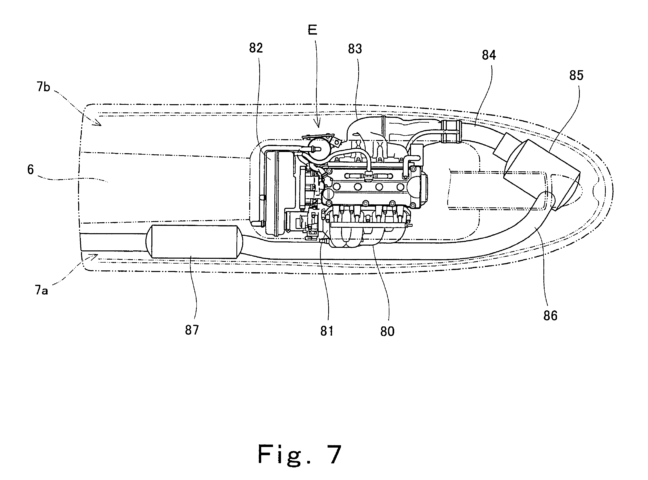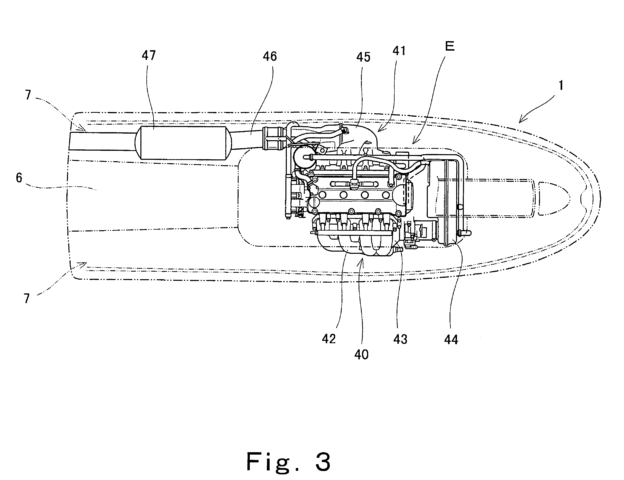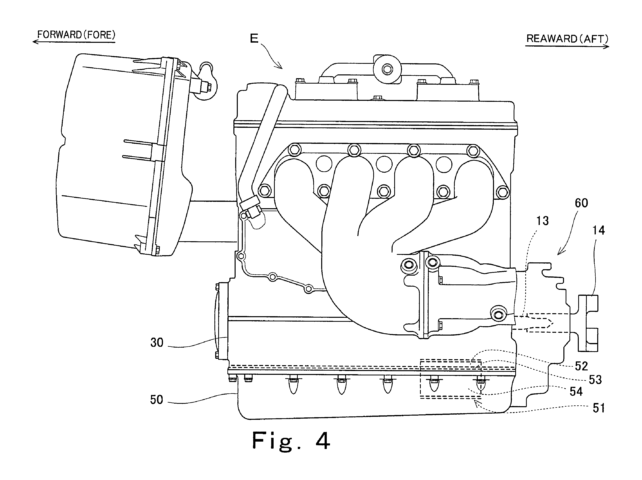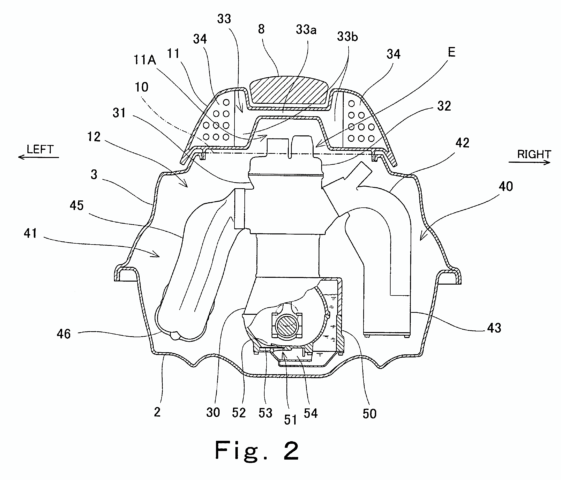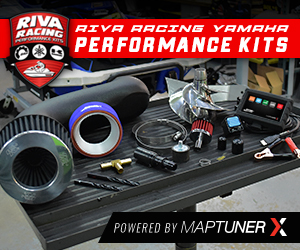
It’s only been two weeks, and already the coals stoked by the teaser video released by Kawasaki (which The Watercraft Journal was first to have published) have begun to cool. Not because of a lack of interest (in fact, quite the opposite as we experienced the single-largest surge of readership in a solitary day), but because there is so little confirmed information concerning the machine. All that is discernible is that the Kawasaki is powered by a powerful four-cylinder 4-stroke and it heralds the return of the SX-R moniker.
But surely there has to be more information on the stand-up’s return out there, right? Well, there is, but you’ll have to don your swami turban and read the tea leaves to rightly predict the future. What we’ve dug up is a series of disconnected threads of information that may or may not weave together.
To begin, we turn to little-known Greek blog www.jetskiworld.gr who chatted up Masanori Inoue, Managing Director of Kawasaki Motors Europe, who stated, “The JetSki brand sends a powerful message about Kawasaki and our desire to create innovative and fun-to-ride products. Using technology from across our internal skill base – including the motorcycle division – we are confident that we will take stand-up personal watercraft to a new level when the new four-stroke SX-R is unveiled in October this year.”
In fact, Inoue has been rather chatty with the blog over the preceding months, giving the website far more information about the intended machine than we’d suspect Kawasaki top brass would care to have disclosed so early. The biggest reveal being the correction of intended powertrain; early reports had the new SX-R receiving the naturally-aspirated 1.5L from the STX-15F, when a blurb was posted that the SX-R will receive a marine-grade version of the H2 superbike’s 1-liter four-cylinder 4-stroke, only to have the report quickly removed altogether. Mysterious indeed! But it does add to Inoue’s heavy-handed “motorcycle division” hint.
Delving into the deep end of the rumor pool, the biggest batch of yet-to-be-confirmed information comes from a post on PWCToday.com. From Cody “cavemanX2650” Burton, who vows was given official insight that the new ski is “12-inches longer than an SX-R and approx 550lbs. Ski will be using a rendition of the 12F engine and a 148mm pump. $10.5k price tag. The two indicators on the handpole are low oil and overheat indicator lights. Slow key for newer riders. Water ingestion issues are being combated through a fully sealed engine compartment and pole breathers.”
This of course, sent anticipations into a tailspin, with many decrying the new SX-R as a “whale,” “barge” and “couch” before even seeing the machine in person. Thankfully, enthusiasts didn’t have to wait long to see it in action as a viral video sprung up of two black-and-white ’17 SX-Rs in action, circling the infamous island of Havasu hot spot Body Beach, taken during the official photography session for the upcoming release (scheduled for October). Through some digging, it’s believed to feature famous Kawasaki riders Victor “Slasher” Sheldon and Minoru Kanamori.
Many have tried to determine both size and riding behavior of the ski from the low-speed photoshoot, but seasoned riders and industry insiders have countered premature criticisms as many understand photos are typically clearer at slower speeds. Nevertheless, certain revelations can be culled from the video, as well as insider information gathered from the Body Beach filming: 1. The ski is significantly larger than the previous SX-R, an estimated 9-feet-plus long; 2. The ski is significantly buoyant, allowing a rider to stand stationary in the tray with the engine off; 3. The ski is significantly taller than the previous SX-R to accommodate the taller overhead valve four-cylinder multi-stroke engine; 4. Black and white is the color combination.
Claims of “a fully sealed engine compartment and pole breathers” also gain partial credence with the reveal of the Kawasaki Patent Application for the new ski found online. Although ZERO measurements are provided in the patent document, certain revelations pertaining to the ski’s weight distribution, unique engine oiling, chainless starter and oil pump drive system, and various configurations of the SX-R’s exhaust are outlined therein. There’s quite a bit of lengthy and indecipherable legalese to weed through, so we’ll share just the highlights:
Weight Distribution & Engine Placement
The stand-up type personal watercraft becomes more difficult to operate with an increase in distance between a center axis of a pump shaft of the water jet pump and the bottom of the watercraft. Accordingly, by mounting the multi-cylinder engine, a distance between the crankshaft and a bottom surface of the crankcase decreases, and correspondingly, a distance between the pump shaft and the bottom of the hull decreases.
Above: Shown are two possible configurations for the 4-stroke SX-R’s exhaust layout – one with a dual waterbox system, and the other with a single.
The four-cycle engine is generally heavier than the two-cycle engine of equal displacement conventionally mounted in the stand-up type personal watercraft. However, by disposing the four-cycle engine near the center of the body, weight in the longitudinal direction of the body is well balanced.
The engine may be constructed such that a cylinder head is located above a crankcase, and may have an air-intake manifold and an exhaust manifold each connected to the cylinder head and extending downward to a lateral position relative to the crankcase. In this construction, since a center of gravity of a combination of the air-intake pipe, the exhaust pipe, and the engine is located lower, the center of gravity of the body is correspondingly located lower.
Unique Oiling Collection & Pickup System
The stand-up type personal watercraft may further comprise an oil tank configured to reserve oil that circulates within the engine, and the oil tank may be placed on an opposite side of the exhaust manifold relative to the engine.
Above: Shown are a second pair of possible exhaust configurations, again one with a single and the other with a double waterbox/muffler system – this time with the mufflers being fixed into the gunnels of the standup, a very interesting proposal!
In this construction, the weight of the body is well balanced. More specifically, by disposing the oil tank having a relatively large weight on the opposite side of the exhaust manifold having a relatively large weight relative to the engine, the weight of the body is well balanced.
The oil tank may have a space elongated in a vertical direction of the body. Within the oil tank, the oil is inhibited from gathering at one side even when the stand-up type personal watercraft turns abruptly in an attitude peculiar to the watercraft.
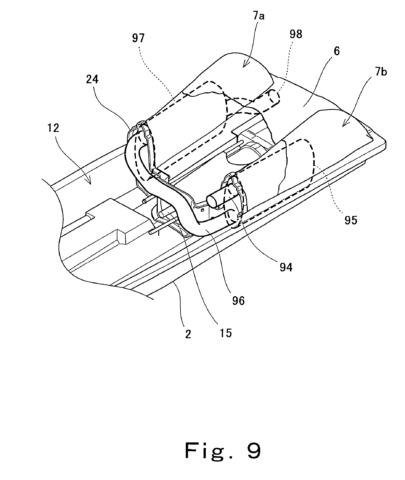
The stand-up type personal watercraft may further comprise an oil-collecting structure disposed at a rear position of a bottom portion within the crankcase, and configured to collect the oil reserved in the crankcase of the engine and to deliver the oil to the oil tank. In this construction, the oil remaining in the inner bottom portion of the crankcase can be efficiently collected when the operator rides on the stand-up type personal watercraft to cause the watercraft to have an attitude with its fore part located higher than its aft part.
Water-Diffusing, Air-Intake Incorporated Into The Hood
The stand-up type personal watercraft may further comprise a deck hood covering the deck opening, and the deck hood may have a concave portion upwardly recessed and opposed to an upper portion of the cylinder head cover so as to accommodate the cylinder head cover therein, with the deck hood covering the deck opening, and an air flow space located laterally relative to the concave portion to allow air taken in from outside to flow therein. In this construction, an increase in the height of the body may be inhibited when the four-cycle engine is mounted in the stand-up type personal watercraft.
The air flow space may form a water separating chamber that serves to separate water from the air taken in from outside. By utilizing an extra space of the deck hood as the water separating chamber serving to separate water from air, water or unwanted substances contained in the fresh air taken in from outside the watercraft can be removed. Further, by vertically providing a plate within the air flow space, or forming a labyrinth structure within the air flow space, the water can be effectively separated from the air.
Crankshaft Gear-Driven Oil Pump and Starter Drive
The stand-up type personal watercraft may further comprises a crankshaft contained within the crankcase of the engine, a starter gear mounted on the crankshaft and configured to rotate integrally with the crankshaft by an output of a starter motor for starting the engine, and an oil pump configured to deliver oil that circulates within the engine, the oil pump being provided with a pump gear for driving the oil pump, wherein the pump gear of the oil pump is configured to mesh with the starter gear.
Above left: Shown is a side view of the engine’s air intake box and exhaust manifold. Above right: A far more detailed cross-section of the proposed hood with the perforated screen integrated into the hood which acts as the first air intake.
Conventionally, the crankshaft of the engine mounted in the watercraft is provided with a crankshaft side pump gear (sprocket) separate from the starter gear so as to rotate integrally with the crankshaft, and the oil pump is provided with a pump side pump gear (sprocket) such that these pump gears are connected to each other through a chain. However, in the above-described construction, the crankshaft side pump gear and the chain are omitted. As a result, a lightweight and small-sized engine is achieved.
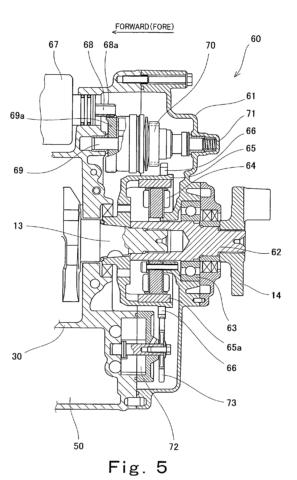
Multi-Muffler (Waterbox) Exhaust Configuration
The stand-up type personal watercraft may further comprise a muffler provided in an exhaust passage of the engine, and an air cleaner box provided in an air-intake passage of the engine, and the muffler and the air cleaner box may be arranged substantially forward and rearward relative to the engine.
The muffler and the air-cleaner box having relatively large inner spaces may generate a buoyant force. In the above construction, buoyant forces generated in front and rear parts of the body are well balanced.
The stand-up type personal watercraft may further comprise a plurality of mufflers provided in an exhaust passage of the engine, and the mufflers may be arranged forward and rearward relative to the engine within the body. In this construction, also, the buoyant forces generated in the front and rear parts of the body are well balanced.
The stand-up type personal watercraft may further comprise two mufflers provided in an exhaust passage of the engine, and deck fins may be provided at right and left side portions of the deck so as to protrude upward from an upper surface of the foot deck, and the mufflers may be contained in the right and left deck fins, respectively. In this construction, buoyant forces generated in right and left parts of the body are well balanced, and a limited space of the stand-up type personal watercraft can be efficiently utilized.
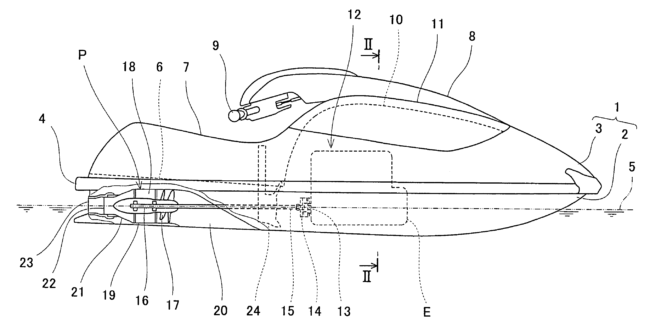
Above: Proportionately, this cross-section image appears to show the previous generation SX-R, and not the new 2017 model. Pay particular attention to the size and placement of the engine. We understand that the 4-stroke engine will protrude above the hood/deck surface.
Finally, the weirdest news, which cannot be confirmed, pertains to Kawasaki USA’s involvement in the development of the new SX-R itself. Rumors have it that the new standup is based off of a prototype first developed in the Irvine, CA headquarters nearly half a decade ago, which was fitted with a 15F engine. Purportedly, the prototype was crated and rushed to Japan less than a year ago where the hull was stretched, widened and lengthened to not only accommodate the larger motor, but retain greater stability, all with the deadline set for this year’s IJSBA World Finals. It’s believed that the development, production, and announcement was all made without the Kawasaki USA team’s input.
Again, this is a puréed blend of internet chatter, leaked online documents and grainy cell phone footage, so take all of this with the prerequisite grain(s) of salt. Prior to October’s worldwide reveal, we doubt much more will seep out into the public arena. Until such time, don’t let the haters get you down or the lack of information make you too anxious to sleep at night. Kawasaki loves to string things out as long as they can for dramatic effect, so just enjoy the anticipation for now.




